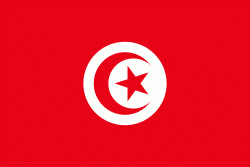Nabeul
Nabeul (نابل ; Tamazight: ⵏⴰⴱⴻⵍ) is a coastal town located in northeastern Tunisia, on the south coast of the Cape Bon peninsula and surrounded by the Mediterranean Sea on both sides. It is the first seaside resort in Tunisia. It is known for its agricultural riches and its touristic potentials. The city had a population of 73,128 as of the 2014 census.
Nabeul was founded in the fifth century BC by the Greeks of Cyrene, serving as a trade port. Its present name is an arabization of its Greek name Neapolis (Νεάπολις, "New City"), which was a common name of Greek colonies. In Roman times, the city was an important trade hub for grain from North Africa to Rome, and a centre for manufacture of garum for Rome.
On 21 July 365, a massive tsunami hit the city from the 365 Crete earthquake, resulting in much destruction and leaving part of it underwater.
During antiquity, Neapolis was also the seat of an ancient Christian bishopric The Bishopric was founded during the Roman Empire and survived through the arian Vandal and Orthodox Byzantine empires, only ceasing to function with the Muslim conquest of the Maghreb.
The diocese was refounded in name at least in the twentieth century as a titular see of the Roman Catholic church. Due to its location by the Mediterranean coast, it remains today a popular tourist destination and is the main centre of the Tunisian pottery industry.
Nabeul was founded in the fifth century BC by the Greeks of Cyrene, serving as a trade port. Its present name is an arabization of its Greek name Neapolis (Νεάπολις, "New City"), which was a common name of Greek colonies. In Roman times, the city was an important trade hub for grain from North Africa to Rome, and a centre for manufacture of garum for Rome.
On 21 July 365, a massive tsunami hit the city from the 365 Crete earthquake, resulting in much destruction and leaving part of it underwater.
During antiquity, Neapolis was also the seat of an ancient Christian bishopric The Bishopric was founded during the Roman Empire and survived through the arian Vandal and Orthodox Byzantine empires, only ceasing to function with the Muslim conquest of the Maghreb.
The diocese was refounded in name at least in the twentieth century as a titular see of the Roman Catholic church. Due to its location by the Mediterranean coast, it remains today a popular tourist destination and is the main centre of the Tunisian pottery industry.
Map - Nabeul
Map
Country - Tunisia
 |
 |
| Flag of Tunisia | |
Beginning in early antiquity, Tunisia was inhabited by the indigenous Berbers. Phoenicians began to arrive in the 12th century BC, establishing several settlements, of which Carthage emerged as the most powerful by the 7th century BC. Carthage was a major mercantile empire and a military rival to the Roman Republic until 146 BC, when it was defeated by the Romans who occupied Tunisia for most of the next 800 years. The Romans introduced Christianity and left architectural legacies like the Amphitheatre of El Jem. In the 7th century AD, Arab Muslims conquered all of Tunisia (finally succeeding in 697 after several attempts starting in 647) and settled with their tribes and families, brought Islam and Arab culture to the local inhabitants, and since then Arabs became the majority of the population. Then, in 1546, the Ottoman Empire established control there, holding sway for over 300 years, until 1881, when the French conquered Tunisia. In 1956, Tunisia gained independence as the Tunisian Republic under the leadership of Habib Bourguiba with the help of activists such as Chedly Kallala, Farhat Hached and Salah Ben Youssef. Today, Tunisia's culture and identity are rooted in this centuries-long intersection of different cultures and ethnicities.
Currency / Language
| ISO | Currency | Symbol | Significant figures |
|---|---|---|---|
| TND | Tunisian dinar | دت | 3 |
| ISO | Language |
|---|---|
| AR | Arabic language |
| FR | French language |















